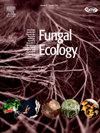形成垫状的地衣支持对比鲜明的微型节肢动物密度
IF 2.2
3区 环境科学与生态学
Q3 ECOLOGY
引用次数: 0
摘要
地衣是冻土带和高寒植被的重要组成部分,影响土壤小气候条件,进而影响节肢动物群落。在这里,我们比较了地衣垫内弹线虫和甲虫的密度以及它们在挪威南部芬斯四种不同地衣垫形成土壤中的丰度。地衣席主要有青衣、岛衣、花衣和黄衣。我们推测,具有高持水能力的地衣创造了一个凉爽稳定的小气候,冻融循环较少,维持了地衣中较高的微节肢动物密度和土壤中的丰度。我们进一步测试了地衣单一栽培对土壤元素有效性的影响。不同地衣种类间小节肢动物的丰度存在差异。毛茛/stygia支持的弹虫密度最高,高WHC地衣支持的弹虫密度较高,且地衣中弹虫数量相对较多。随着土壤含水量的增加,甲虫对地衣垫的响应比弹尾虫低,但对土壤地衣垫的响应增加。地衣垫密度、土壤温度和冻融循环与微型节肢动物丰度无相关性。由于温度和冻融循环的差异,裸露土壤的元素有效性高于覆盖地衣的土壤,这可能会影响微生物的活性。在北方和冻土带生态系统中,由于环境变化,地衣覆盖将减少,这可能会对以地衣为主的植被中的微型节肢动物群落产生重大影响。本文章由计算机程序翻译,如有差异,请以英文原文为准。
Mat-forming lichens support contrasting micro-arthropod density
Mat-forming lichens are important components of tundra and alpine vegetation, and affect soil microclimatic conditions, which in turn may influence micro-arthropod communities. Here, we compare the density of Collembola and Oribatida within lichen mats and their abundance in the underlying soil across four different mat-forming lichens at Finse, southern Norway. The lichen mats consisted of Alectoria ochroleuca, Cetraria islandica, Cladonia rangiferina/stygia, or Flavocetraria nivalis. We hypothesized that lichens with high water holding capacity (WHC) create a cool and stable microclimate with few freeze-thaw cycles which sustains a high micro-arthropod density in lichen and abundance in soil. We further test how lichen monocultures affect soil element availability. The abundance of micro-arthropods differed among lichen species. Cladonia rangiferina/stygia supported the highest Collembola density, and lichens with high WHC supported higher densities, and relatively more Collembola in the lichen than the soil underneath. Oribatida were less responsive than Collembola but increased in lichen mats relative to soil with increasing WHC. Lichen mat density, soil temperature and freeze-thaw cycles did not correlate to micro-arthropod abundance. Element availability was higher in bare soil compared to soil covered with lichens driven by differences in temperature and freeze-thaw cycles, which possibly affect microbial activity. Lichen cover in boreal and tundra ecosystems is expected to decrease due to environmental change, which may significantly impact micro-arthropod communities in lichen-dominated vegetation.
求助全文
通过发布文献求助,成功后即可免费获取论文全文。
去求助
来源期刊

Fungal Ecology
环境科学-生态学
CiteScore
5.80
自引率
3.40%
发文量
51
审稿时长
3 months
期刊介绍:
Fungal Ecology publishes investigations into all aspects of fungal ecology, including the following (not exclusive): population dynamics; adaptation; evolution; role in ecosystem functioning, nutrient cycling, decomposition, carbon allocation; ecophysiology; intra- and inter-specific mycelial interactions, fungus-plant (pathogens, mycorrhizas, lichens, endophytes), fungus-invertebrate and fungus-microbe interaction; genomics and (evolutionary) genetics; conservation and biodiversity; remote sensing; bioremediation and biodegradation; quantitative and computational aspects - modelling, indicators, complexity, informatics. The usual prerequisites for publication will be originality, clarity, and significance as relevant to a better understanding of the ecology of fungi.
 求助内容:
求助内容: 应助结果提醒方式:
应助结果提醒方式:


